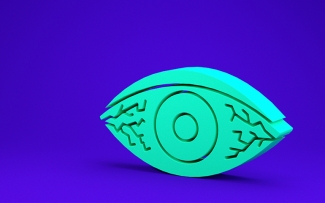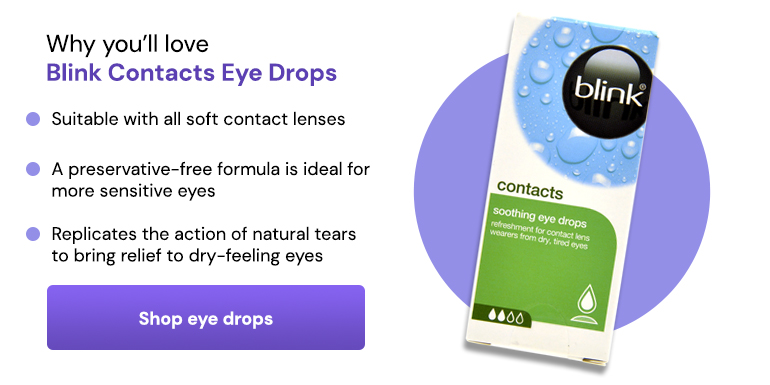What is dry eye syndrome?
Dry eye is a common condition where either your eyes don't produce enough tears or where the tears evaporate too quickly. It is also known by the medical term' keratoconjunctivitis sicca'.
This condition currently affects two in three adults in the UK.
What causes dry eye?
The front surface of the eye is covered by a thin layer of liquid called the tear film. This layer helps ensure the eye remains moist whilst nourishing and protecting your eyes against infection. The tear film is made up of three layers: the oil layer (lipid), the water layer (aqueous) and the mucous layer.
Dry eye is caused when your eye doesn't have enough of one of these layers. Although it may affect people of any age, your chances of developing dry eye syndrome increase as you grow older.
What are the symptoms of dry eye syndrome?
- Itchiness
- Redness
- Watery eyes
- A feeling of dryness or soreness
- Feeling like there is 'grit' or 'sand' in your eye
- Eyelids that are stuck together when you wake up
Severe dry eye symptoms may include:
- Blurred vision
- Sensitivity to light
- Extremely red and painful eyes
If you experience any of the above, you should arrange an appointment with your optician.
What factors cause dry eye syndrome?
There are many different factors that can contribute to dry eye, although a single identifiable cause can't often be found. Below is a list of common causes:
- The environment: The sun, wind, a dry climate, air conditioning & using a computer for long periods of time can have a drying effect on your eyes. Your tears will evaporate quicker than they can be reproduced in these conditions and therefore leave you with dry eyes.
- Ageing: As you age, the eye naturally produces fewer tears. The eyelids become less effective at spreading the tear film evenly across the eye, leaving dry patches.
- Contact lenses: Wearing your lenses for longer than suggested can cause your eyes to become dry and irritated. New materials tend to be more breathable, but you should always follow your wear schedule advised by your optician.
- Pregnancy & Menopause: During pregnancy & menopause, a woman's hormone levels change frequently and as such, the body's production of tears can be affected. This results in a reduction of moisture levels in the eye.
- Medical conditions: There are a number of medical conditions that affect the body's production of tears, such as Sjögren's syndrome: a condition that can cause excessive dryness of the eyes, mouth and other organs, and rheumatoid arthritis: a condition that causes pain, swelling and inflammation of the joints but also the glands around the eyes.
How are dry eyes diagnosed?
Your optician can typically diagnose dry eyes from a simple conversation about your symptoms. They may ask a range of questions to determine the severity as dry eyes can be a sign of an underlying disease.
Your optician will use a yellow-orange dye called fluorescein which will allow them to see your tears more clearly. This helps them calculate how long it takes for your eyes to begin drying out and whether it's within average limits. If there is damage to the eye, the fluorescein dye may highlight the affected areas.
How do you treat dry eye?
The good news is there are lots of things you can do to help minimise dry eyes and keep your eyes healthy this winter.
- Artificial tear drops (or eye drops) are usually the first line of defence for alleviating mild to moderate dry eyes.
- Applying a hot compress to closed eyelids for a few minutes a day can help to clear blocked oil glands.
- Drink plenty of water — aim for 8-10 glasses a day.
- Limit screen time — when you're using digital devices, take regular breaks and try to blink fully and often (blinking spreads that all-important tear film across the surface of your eye).
- Avoid sitting too close to heat sources, like fires or fan heaters, and use a humidifier at home to help slow down the evaporation of your tears.
- Get enough sleep — 7 to 8 hours gives our eyes the chance to rest and replenish.
- Avoid dusty, windy and smoky environments, and if you're outside a lot, try wrap-around glasses to protect your eyes from the elements.
- Contact lenses for dry eyes — Lenses with technologies that work alongside the eye's natural tear film tend to perform best in our findings for dry eye sufferers.
- Switch to specs — if your contacts are causing further irritation, give your eyes a break for a few days.
Blink Contacts eye drops have been developed to bring relief to contact lens wearer's eyes. They work by replicating the action of natural tears, essentially moisturising dry-feeling eyes and reducing discomfort.
To help manage eye-dryness symptoms, Blink Refreshing Eye Mist is an easy-to-use alternative to eye drops for those who want extra refreshment during the day or for those who find eye drops difficult to use. The mist is designed to hydrate, refresh and lubricate dry-feeling eyes. It can be used with or without contact lenses.
Your optician will be able to recommend the best-suited product for you to use, which may be found from our full range here. In some cases, a more medical approach to treatment may be required.
Always consult with your optician if you feel like your symptoms have persisted or if you believe your contact lenses may be a contributing factor.
The NHS has more information on Dry Eye Syndrome for you if needed here https://www.nhs.uk/conditions/dry-eyes/

Managing dry eye in every season
Harsh weather conditions and seasonal changes can have a big impact on the health of our eyes. At some point, almost everyone experiences that dry, scratchy sensation in their eyes. Yet, for some people, dry eye is more than a temporary annoyance.
Dry eye in the summer
The heat and humidity of the summer months can sap the moisture from our eyes and leave them feeling parched. And while air conditioning offers a reprieve from the heat, it's likely to exacerbate the drying effects.
Facial cleanliness is vital for good eye hygiene, especially during the summer when exposure to sweat, sun cream, chlorine and dust may further irritate the eyes. Be sure to wash your face and eyelids at the end of the day to keep your eyes debris-free.
Artificial tears are often the first line of defence if you have dry eyes. Drinking plenty of water is also essential to keeping your eyes healthy and hydrated in warm weather. Your eyes will also benefit from adjusting fans or air conditioning units so that they're not blowing directly in your eyes.
Seasonal sufferers should try to avoid outdoor activities that may aggravate allergies, like gardening, or if that's not possible, slip on a pair of safety goggles or sunglasses to protect your peepers from pesky irritants.
Dry eye in the autumn
Dry, cold air is often the culprit of dry eyes during autumn. Keep your eyes moist with artificial tears and try to avoid heated rooms and other low humidity environments.
Allergies also tend to act up in autumn due to an influx of airborne allergens, such as mould spores or ragweed pollen. If your itchy eyes are combined with sneezing and a runny nose, then autumn allergies could be the problem.
If you're a contact lens wearer suffering from seasonal allergies, it's recommended that you wear glasses for a couple of days a week to ensure that your eyes remain feeling comfortable. Consider speaking to your optician about switching to daily disposables during the autumn months to avoid the build-up of allergens on your lenses.
Dry eye in the winter
Our eyes have a lot to contend with during the winter months. Cold air and gusty winds can reduce the natural moisture in our eyes, causing them to dry out. Yet, staying cooped up indoors with heaters, fires, and increased screen time can have the same drying effect as the wintery weather outside.
So, what can be done to remedy these effects? Consider using a humidifier at home to increase the moisture in the air, use rewetting drops to lubricate the eyes, and try to avoid sitting too close to heat sources like fires or fan heaters. Drinking plenty of water will also help to maintain moisture in the eyes.
Dryness can be particularly debilitating for those who wear contact lenses. If your contacts are causing further irritation, give your eyes a break and wear glasses for a few days. Alternatively, speak to your optician about switching to silicone-based hydrogel lenses, which offer more comfort than the traditional lens.
Dry eye in the spring
Dry eye symptoms spike during April when the pollen counts are at their highest. When these seasonal allergens creep into the tear film, they can cause the Meibomian glands in the eyelids to become blocked. As a result, it cannot produce the essential oils required for a stable tear film, which can cause dryness and inflammation in the eye. Antihistamine eye drops, which help alleviate hay fever-related symptoms can reduce the production of mucous, found in the tear film. This in turn can also lead to dry eye symptoms (It is usually recommended that those who use antihistamine drops for hay fever, should also use artificial tears to keep the eyes comfortable).
An obvious solution is to avoid allergens, although if that's not possible, there are other steps that seasonal sufferers can take to minimise the effects. Slip on a cool eye mask to reduce inflammation or wear sunglasses outside to help reduce the amount of pollen entering the eyes.
If you find that your dry eye symptoms flare up every spring, seasonal allergies might be part of the problem. However, the only way to be sure is to be tested for dry eye.
Making a few simple changes to your lifestyle can help combat dry eyes and keep your eyes comfortable. But if you're still feeling discomfort, speak to your optician, and they'll help you find a solution. Depending on the type of dry eye you have, your optometrist may suggest supplements, stronger eye drops or switching to a more hydrating contact lens.
Roshni Patel BSc (Hons) MCOptom




